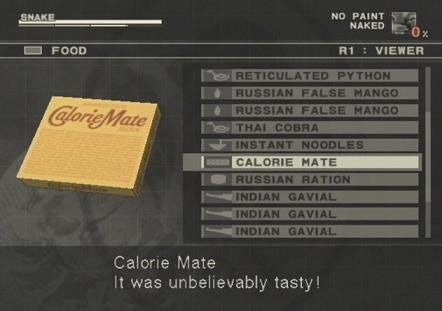
A blond American man pushes desperately through a crowd of Japanese school girls on a speeding train. “Copy?” he murmurs into an ear piece. “I’m in position.”
The train is cluttered with yellow banners that hang from every available surface, and despite his lurching race, no one seems fazed by this stranger. They’re all too busy chatting with friends and enjoying snacks.
The same snack. In fact, it’s the snack advertised on the chaos of banners. The man is Kiefer Sutherland, and when he finally breaks free onto the station platform, he pauses for a moment to slurp down the contents of the ubiquitous foil pouch, too. He’s on TV advertising Calorie Mate.

Before even speculating about what Calorie Mate is, it’s hard not to be enamored with its packaging. Each crisp, yolk-yellow box is decorated with a bold typographic design that pairs its logo’s sweeping script with a block of tight text. The different colors signify five flavors: cheese, fruit, chocolate, maple, and plain, which was announced with some fanfare in 2014.

But if you’re expecting an American-style protein bar, you’re in for a surprise. Calorie Mate was developed in 1983, capitalizing on fascination with space food. It’s made by Otsuka Pharmaceutical Co. Ltd., the same company behind SoyJoy bars and Pocari Sweat, a sports drink you can find in vending machines and convenience stores all over Japan.
As the presence of the word “pharmaceutical” suggests, Otsuka’s snacks and beverages are formulated in the lab, rather than the kitchen. In addition to its best known format — blocks with a cakey, crumbly consistency that recalls shortbread — Calorie Mate is also available as a jelly or a canned drink, which were intended for use in medical institutions where patients might struggle with solids. (An interesting tangent: Japan is also developing safer liquid and semi-liquid foods for its rapidly aging population.)
Back when the commercial aired in 2007, Sutherland was promoting 24 — but it wasn’t the last time he’d be drawn into Calorie Mate’s loose web of pop culture appearances. By the time Sutherland voiced the main character in Metal Gear, the franchise already had its own funny, weird ties to Calorie Mate, which is a consumable item in the game.
In one memorable scene, two of the game’s main characters, Snake and Eva, banter about Calorie Mate, ostensibly to teach players about the unfamiliar food item. But their discussion Calorie Mate’s benefits — balanced nutrition, plentiful vitamins and nutrients, and weight loss support — feels ripped straight from a commercial. Eva slyly tries to convince Snake to give her his Calorie Mate, and the two debate whether the it’s the secret to geisha’s slim figures.

The game makes Calorie Mate sound so tempting that Metal Gear fans all over the world have ordered it online (and debated its taste on Reddit).
So, Calorie Mate is a video game novelty and a possible nutritional supplement. But if it’s so widely sold in convenience stores, who is it actually for?
The answer isn’t too surprising: The same population of busy workers who’d just as soon reach for a glass of Soylent or careful calorie counters who yearn for a source of fuel more predictable than ordering a restaurant meal or packing a lunch. In fact, New York Magazine’s The Strategist named Calorie Mate the best meal replacement supplement, displacing Soylent. “Is it healthy?” the glowing review asks. “No, but that’s not the point of Calorie Mate. The point of Calorie Mate is to fill you up for many hours, without requiring you to spend time or money preparing a meal.”
Some nutritionists are begging Calorie Mate fans to change their ways. For one thing, Japan doesn’t require food producers to disclose the presence of trans fats — which are almost certainly hidden in the snack’s hefty dose of vegetable shortening. As always, it’s good to be reminded that there aren’t really shortcuts to eating a healthy diet.
But on our trip we discovered that Calorie Mate serves another key purpose: Warding off hangry feelings. We might not have been fighting terrorism like Jack Bauer or carrying on covert missions like Snake, but it turns out Calorie Mate is just as helpful while roaming around new cities or enduring back-to-back red eye flights.
Something else

I’ve been working on some bigger projects behind the scenes, and last week one of them finally launched! Last fall, I spent two months combing online archives for the materials that became Primetime, a new Vox podcast hosted by Todd VanDerWerff.
The show explores history at the intersection of television and the American presidency, starting with The West Wing and moving on to other fascinating moments from the past half century.
If you like Scavenger, you’re going to love Primetime. You can listen online or subscribe wherever you get your podcasts.
(For anyone on the list who doesn’t listen to podcasts regularly — hi Mom and Dad! — think of them as a serialized radio story you can listen to online.)


